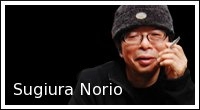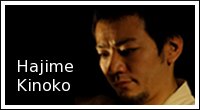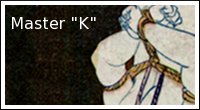Q & A with Zetsu
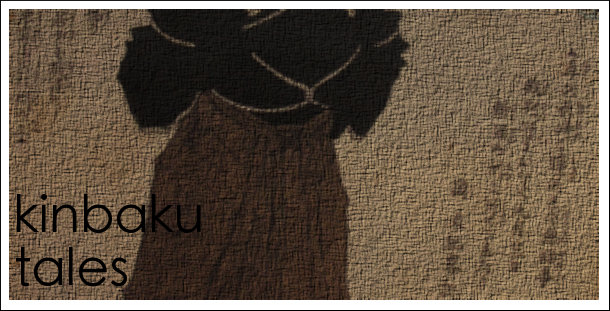
I first came across Zetsu on FetLife (where else?) several months ago. He is a student of Master K's and contacted me to tell me that both he and K would be visiting Tokyo around the same time. Master K's book, The Beauty of Kinbaku, was going to be published in Japan and K was coming over to sign the contract. For his part, Zetsu is in the planning stages on a book and was coming over to conduct research.
They had quite an adventure, meeting with the likes of Nureki Chimuo, Arisue Go, Naka Akira, Urato Hiroshi and Yukimura Haruki, so it seemed an interview was in order.
KJ: How many times have you been to Japan in the past and what did you do on those occasions?
ZETSU: This was my fourth trip to Japan. I have never been outside of Tokyo and have previously only been on business with one small exception, which was meeting Osada Steve almost three years ago. I visited him at Studio SIX for a lesson and to watch one of his shows. When he found out I was in Los Angeles, he told me I should get in touch with “his friend K". It took me a year before I was able to do that for personal reasons, but eventually I did and that was the start of my relationship with K sensei.
Did you plan to come over with Master "K" or was it just a coincidence?
Lucky for me, I had a project in Tokyo that allowed me some flexibility in travel, so when K told me about his invitation from Nureki Chimuo, I offered to assist him on this trip as much as I could if we could make our schedules mesh while we were both there. As it turned out, we were able to schedule our trips to overlap for almost the entire time, except for a few days at the beginning. I stayed a few days longer as well to finish my work and visit with some friends.
Give me a rundown on your activities this time.
The trip was like a kinbaku dream! I was there to help K sensei with what he needed and he was very gracious to allow me to sit in on some of the meetings with people who have been people I have admired greatly from afar.
The trip started for me by assisting with a lesson (something I have the privilege of doing with Master “K” here in LA quite often), but instead of having K sensei teaching, he was the one taking the lesson from none other than Urato Hirsohi! Urato-san was an absolutely charming man with a ton of energy and enthusiasm and watching him teach and tie was truly a sight to behold.
He taught for close to three hours, showing some very interesting variations of the takate kote, how he ties the traditional hishi pattern, talking about the different kinds of rope he used, and treating us to all sorts of stories about his life in the movies rigging for Nikkatsu films. So here he was, teaching a class and talking about what it was like to tie Naomi Tani!
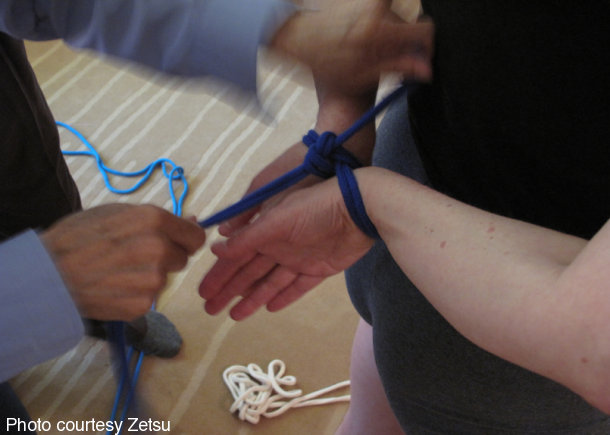
In one amazing moment, he started to show us how one rigs a sakasa (inverted) suspension by lifting the model up on his shoulder and starting to tie her ankles. You have to understand that Urato-san is almost 80 years old and very small. The model was a Western woman, probably 5’10”. Watching him pick her up like that nearly gave us a heart attack!
At one point Urato-san wanted to show something different and the model was taking a break, so he ended up tying me instead. It was quite an experience.
Urato-san didn’t address me directly during the lesson (even when he was tying me) and it wasn’t until we were leaving, walking down the hallway that he had a very animated conversation with the translator which involved quite a bit of pointing at me. Whatever I had done during class had apparently met with Urato-san’s approval because as the translator explained it, I was now “on his radar". Quite exciting!
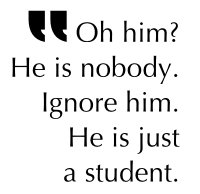 The next day we were off for the main event, a full day at a photo shoot with Nureki Chimuo sensei. This was a remarkable experience, just being in the same room with the man whom many consider to be the greatest living bakushi. As much as I was excited, I was also a bit petrified. For as long as I have been interested in kinbaku, I have heard stories about Nureki.
The next day we were off for the main event, a full day at a photo shoot with Nureki Chimuo sensei. This was a remarkable experience, just being in the same room with the man whom many consider to be the greatest living bakushi. As much as I was excited, I was also a bit petrified. For as long as I have been interested in kinbaku, I have heard stories about Nureki. And one of the things I had heard was that he was a very demanding presence. I had been told by our translator that just getting me into the shoot had been the subject of some serious negotiation, so that I needed to make myself pretty much invisible. Of course, the fear was not only for myself, but being K sensei’s student, whatever I did was going to reflect on him as well.
Throughout the shoot, I sat quietly and watched what was truly an amazing experience of Nureki tying and directing the shoot. I pretty much limited myself to breathing and blinking. I am not even sure I moved in my chair for the hours we were there. In one of the more amusing moments, the photographer (the legendary Kei-san), whom I had seen looking over in my direction a few times, asked our translator who I was. She told him, “Oh him? He is nobody. Ignore him. He is just a student.” That seemed to satisfy him and he nodded in what seemed to be a mixture of understanding and approval.
I was busily watching and tried to steal every bit of knowledge I could from watching this master at work. He did not disappoint. His rope work was amazing, fluid, and beautiful. He did quite a few things which I had never seen before. Small, discrete variations, especially on his high-hand tie, which left me mesmerized. I sat and listened from across the room while he and K sensei had a conversation and after that, we were off, left to think about and process what had been a truly profound experience.
Friday was jam-packed as well, starting with a trip to Meiji University to the Nawa Yumio exhibit of the history of law enforcement and punishment in Edo era Japan.

It is a small but remarkable exhibit, which features a lot of examples of how rope was used in everything from hojojutsu to tortures, including suspensions.

Once the curator was informed K sensei was visiting, he stopped his work for the day and showed us around, providing remarkable detail about every aspect of the exhibit. He was even fluent in English, so the detail he was able to provide was quite nuanced.

Next up was K’s meeting with his Japanese publisher. The meeting was at a charming little coffee shop in Kanda where K sensei met with the head of the publishing company to sign the contract for the Japanese version of The Beauty of Kinbaku. It was quite thrilling to be there and I was even asked to sign the contract as a witness. It was truly an honor to be included in that way.
I also had a chance to share something with Urato Hiroshi that morning which was very special to me. Urato-san was at the meeting because he had been instrumental in connecting K sensei to the publisher. At the end of the meeting, I couldn’t resist sharing something with him.
Urato-san is not someone who pays a lot of attention to the high tech world. In fact, I was told he had only recently got a telephone installed at his home. It just so happened that before leaving for the trip, I had put a copy of Wife to Be Sacrificed, probably Urato-san’s most famous film, on my iPhone. So here we were in a Kanda coffee shop and I am showing Urato Hiroshi a copy of his work on my iPhone! Immediately he started telling us stories about the film. Script rewrites, stories about the actors, production issues and problems. It was like he was flashing back 35 years and the details popped out of him like it was yesterday!
Afterward, we spent the afternoon used-book shopping in Kanda and Urato-san took us to all his favorite used book stores. My collection of kinbaku books grew impressively that day, including some very early magazines which are impossible to find in the US.

It was amazing to see complete runs of Kitan Club, SM King, Uramado, SM Select and countless other magazines available in these shops.
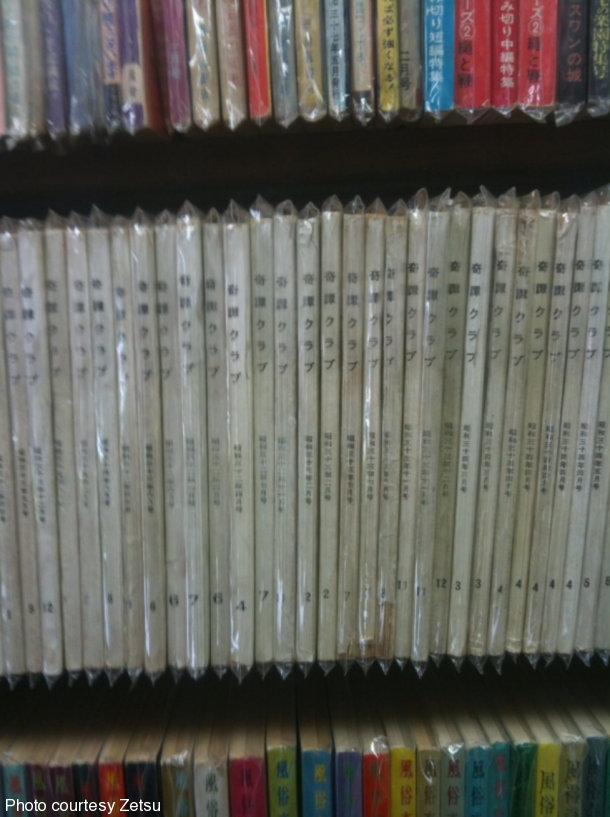
One of the best moments was finding a copy of Nawa to Ona, a 1972 book which featured Urato-san’s rope work and which he happily autographed for me as well. One of the highlights of the trip.
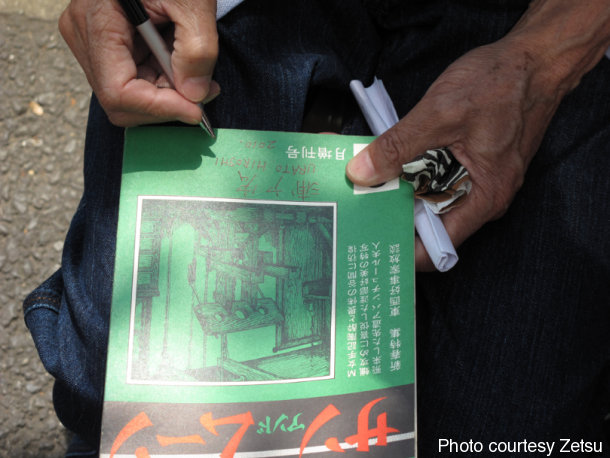
That afternoon, Naka Akira came by for coffee and to spend some time chatting with K sensei. One of the most remarkable things for me was the way in which these amazing and legendary men all recognized in K sensei a kindred spirit. In each case, I mostly just sat quietly and listened as I watched a conversation between peers, born of mutual respect for each other’s work, tying and love of the art. Naka-san was a complete surprise to me. I had seen him in videos and pictures and was expecting a serious and stern presence but found him to be exactly the opposite.
Everything about him was joyful. He comes across as a man half his age, with a near constant smile and a love of laughter. He was full of energy and had such passion for rope and the art that even after a long day, I found myself energized just listening to him talk.
On Saturday, I had the honor of meeting Yukimura Haruki, which was also an amazing experience. Even though I only was able to spend a short period of time with him (K sensei saw him much more and even took a lesson with him), he made an incredible impression on me. It was one of those moments when everything seems surreal. There I was, standing in the home of Yukimura and he is talking to me, friendly as can be. Of all the bakushi I had seen, Yukimura has always been the one that moved me the most deeply and being there, I could literally feel his presence across the room.
On Friday I had found a copy of his book, Transbody Bondage, and had the presence of mind to bring it with me. He graciously signed it for me, with his calligraphy set no less!
As we were leaving, walking back to our cab, we heard a voice behind us. Down the stairs comes Yukimura waving something in his hands. He had wanted to give us a set of photo stills that were taken as part of the promotion for the movie Bakushi. He handed us each a little red package of a dozen or so beautiful photos of his work. I was overwhelmed by his generosity and absolutely treasure the memory of that encounter.
Sunday, we had the opportunity to meet with Arisue Go and Kogure and got to hear all about his work on the new film Flower and Snake 3. I listened as K sensei and Arisue sensei talked about the philosophy of kinbaku, Arisue-san’s experiences in film and their various philosophies of teaching.
On Monday, I was privileged to meet again with K sensei and Urato Hiroshi for a very special meeting and discussion, but I will leave that story to be told by K sensei.
The afternoon ended with Urato giving us a two-hour oral history of the early days of kinbaku and what it was like to work with Minomura Kou, and work beside Nureki when they were both young men. He also talked about his long-time friendship with Dan Oniroku as well as some of the other luminaries in the history of kinbaku.
That night, we had a very nice evening with rida and K sensei did a wonderful kinbaku session with her, which she has written up and described beautifully on her blog.
Tuesday, K sensei departed Tokyo and I was left to my own devices and got an opportunity to meet with a few friends in Tokyo as well as tour some of the rope shops and adult stores around town, including some dinners, tonkatsu, and more book, poster, rope and ukyio-e shopping with a certain blogger who shall remain nameless.
One great find was Sunshop II in Akihabara. Much to my amazement, among all the Japanese books and periodicals, I found a copy of K sensei’s book prominently positioned. Quite exciting as you can’t even find that in the US.
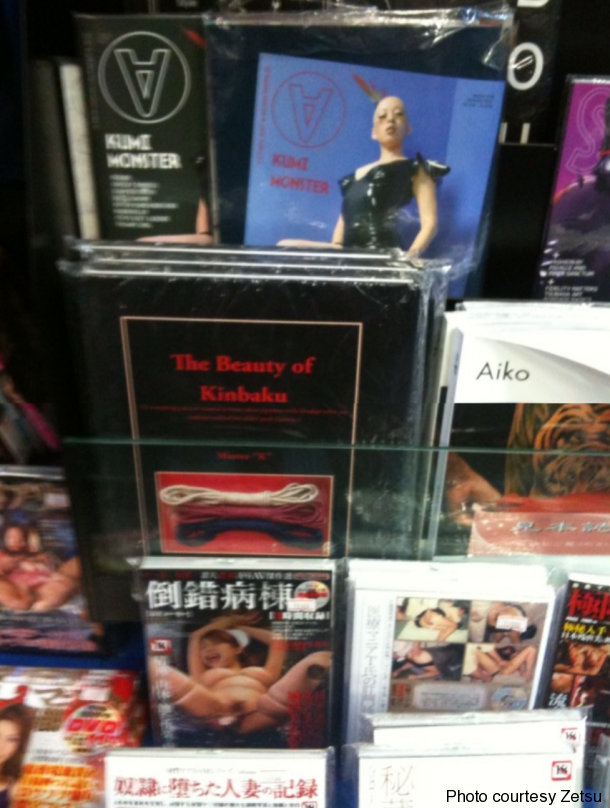
When all was said and done, I returned home with quite a collection of booty!
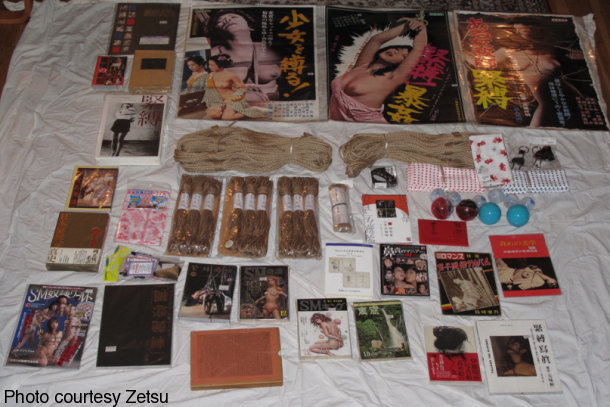
How long have you been interested in bondage and Japanese bondage in particular?
When I started getting involved in the BDSM lifestyle about two years ago, someone asked me if I always knew I was kinky. I told them, “No, not at all. I didn’t realize I was kinky until I was like six or seven years old.” And that pretty much sums up my experience. I had always known this was an interest.
As a kid I would often go to the local magazine shop and look over the covers of magazines that were supposed to be detective stories or “true crime” magazines, which invariably would have a woman tied up and in peril on the cover. I was always drawn to that kind of imagery. But it wasn’t until I came across an image of kinbaku on the computer from an old BBS (this was pre-internet) that I found a true passion. The pictures, which were classic Showa-era bondage, resonated with me very powerfully and after that, all other bondage to me felt like a pale imitation. That was a big part of the reason I sought out Osada Steve during my first trip to Tokyo, just to see and experience this close up. I never really thought I would be tying some day and be as connected to kinbaku as I am now.
How did you meet Master "K" and how often do you get together?
I am very proud to say that K sensei is my teacher, but even more proud to call him my friend. We do tuition-based classes twice a month, which is the core of my kinbaku study, but we frequently see each other socially as well, usually for lunch or dinner about once a week. A lot of our discussion involves the art, history and philosophy of kinbaku and goes beyond tying.
About once a month I try to arrange a get-together of interested people for a demo or presentation which K sensei leads. Sometimes it involves a movie viewing or showing some art or rare books from his collection. One of his missions is to “get the message out” about what kinbaku is and why it matters, so I try to be helpful with that.
About twice a week, I host classes at my apartment as well, as it is located in an area that is easy for his students to get to and because I am learning how to teach kinbaku as well as practice it. Teaching how to tie is a very different skill set from doing it and when I told K sensei that I would like to teach at some point, he started inviting me to assist with his lessons. We usually spend some time debriefing after he teaches a class so he can help me understand that part of the art better as well. I am hoping I will advance enough as a student and a teacher that at some point he will allow me to start teaching some of the basics. But that is probably still a ways off.
One of the best things about working with K sensei is that he really takes kinbaku seriously and not just as a technical exercise. He wants to teach his students how to become bakushi and that means understanding the intention, the art, the psychology and the connection that kinbaku provides. Technique is the foundation, and doing your ties correctly and safely is vital, but in the big picture it is actually the least important part. You learn to tie so that you can create a connection with your partner and that is where the magic happens.
Why wasn't rida nekkid? Why are you guys such gentlemen?
She was naked under her clothes!
Okay, this is actually a serious question at some level. So much of what happens in kinbaku is both a sensual and layering experience. One of the things I have learned from K sensei is that kinbaku with a partner is an exploration and that it is okay to start with a bit of modesty and slowly build the connection and intensity to make your kinbaku more intimate over time. It was not at all surprising to me that he wanted to tie rida the way he did, because much of what he was doing was exploring her reaction to the rope.
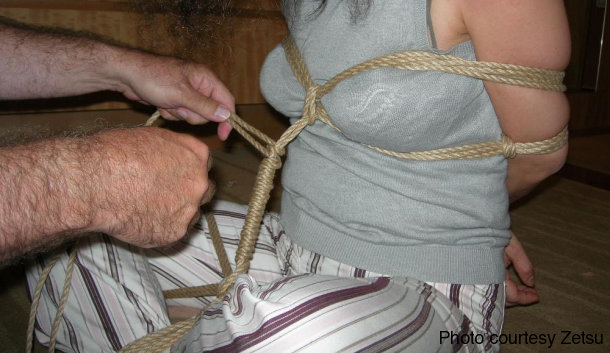
Another lesson I have learned from K sensei is that the art of kinbaku is not in the tie itself or the technique; it is in matching the tie to the woman. Part of that is knowing what is going to look good on her, but as important is knowing what is going to make her feel good. When done properly, the woman actually changes in the rope. And naked or not, I got to witness that transformation with rida, which was a true joy to see!
Why did Master "K" stay in such opulence and you were in that dump? (Just kidding. Your hotel was nice).
One of the things K sensei made a point of saying was that in all his previous trips to Japan, and especially living there as a student, there were many things he never got to do because he was a poor, struggling student. This time, he was determined to do those things and to make everything first class all the way. That meant staying at the Okura and eating at top restaurants. All I can say is that he was very generous in letting me tag along as much as he did. I think I was indirectly very lucky that he had such a tough time in the 1970s, because I got to be there when he was making up for it!
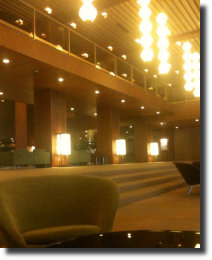 The Okura is an amazing hotel; it made me feel like I was in a James Bond movie from the 1970s with its décor and rich opulence at every turn. Truly a remarkable place.
The Okura is an amazing hotel; it made me feel like I was in a James Bond movie from the 1970s with its décor and rich opulence at every turn. Truly a remarkable place.What was your favorite part of your most recent trip?
There must have been a dozen times when K sensei and I just looked at each other in disbelief because pretty much every day we were there something amazing just fell into our laps. I can honestly say there is not a single thing I would change about the trip. Almost every single thing we did ended up being more than I had expected or hoped for. There were too many amazing things to even try to name five or ten favorites.
Probably the most inspiring, though, was meeting Yukimura sensei. Just meeting him for a brief time was a life-changing experience for me. And, honestly, I can’t even articulate why.
One of the greatest joys was shopping for ukiyo-e pictures and coming across something I had never seen before: a print by Yoshitoshi of a man in a hojojutsu tie.

I couldn’t afford it, but I thought K sensei might be interested as a collector of art, and because I knew he particularly loves Yoshitoshi’s work. I took a snapshot of it and sent it to him in an email, because he had already returned to the US by then. Much to my surprise and delight, it was a print he didn’t already own and it was depicting the very tie that Yukimura had been demonstrating as part of his lesson with K sensei! Needless to say, he purchased it immediately once he saw the picture. He didn’t tell me, but instead surprised me by showing it off during one of his lectures and telling the story of how it came to him. Of course, I was delighted to help him find something that turned out to be so meaningful to him.
Least favorite part?
Easy. Having to go home. Other than that, I wouldn’t change a thing.
What is it about Japan that you like?
The people, the culture, the food, the energy of the city, the history and the connection to something that moves me in a way I don’t have words for.
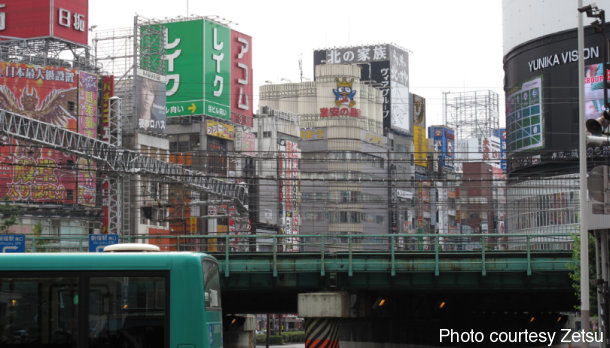
It is a very odd experience to be in a city where you look different from everyone else, can barely speak the language, are functionally illiterate, and hit your head on nearly everything because you are so tall, but oddly you feel like you are home. I also love the way that sexuality is much more accepted within Japanese culture, particularly SM.
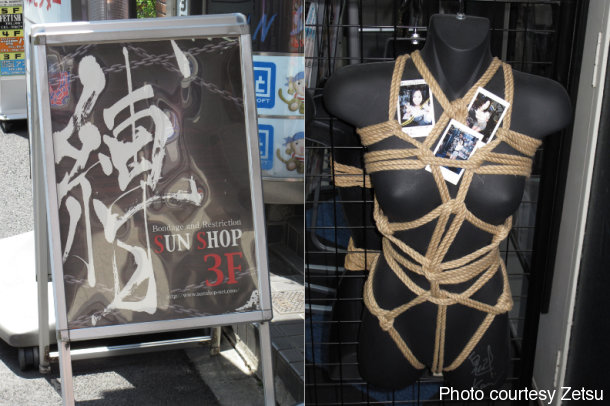
I enjoyed visiting the various adult shops, from specialty stores like Sun Shop to more mainstream places like M’s Pop Life and Love Merci. Invariably, all of them had rope for sale and SM goods usually had their own dedicated section or floor.
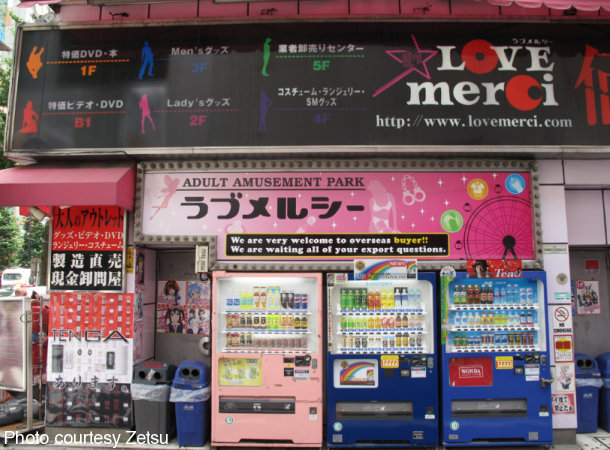
There is something about being in Japan that I find comforting. It is a combination of propriety and unfailing politeness that almost defines the national character. It is always a little difficult for me to return to America after staying for any length of time in Japan because I am always struck by how rude a nation we are in comparison. I always end up spending a little bit of time trying to help Japanese visitors from my flight find their way through the airport and to a cab or to their hotels because invariably someone had shown me a similar kindness in Japan.
Although, in Japan many people speak English and many of the signs are in English as well and Japanese visitors to America do not have that same luxury. I guess it is part of how I transition back to being home.
What have you been doing since returning home?
My lessons have been continuing and K sensei has integrated a lot of what he learned from Urato sensei and Yukimura sensei into his teaching style. So that has been a very interesting thing to watch, both as a student and in seeing him teach others. K sensei had some students in from Montreal and I was able to host their lessons at my place so I very much enjoyed watching him teach at a very high level as well.
I have been spending a lot of time pouring through all of the materials I managed to bring home from Japan. I got a lot of very interesting historical reference works as well as some great inspirational material.
I have been talking with a few of the rope sellers in Japan and I am working on a project to start selling some high quality jute in the US, working with those companies to import their rope and sell it here as well. If we can get all the details worked out, I think it will be very exciting.
How's your book coming along?
Thanks for asking! The book is still very much in the research stage, but coming along very well, I think. The goal of the book is to provide a comparison between the emergence of erotic leather culture in the US and erotic rope culture in Japan as they each seemed to form during roughly the same time period, post-World War II. I believe there is something in each that speaks to cultural and national identity: rope in Japan and leather in America. So part of the question I am asking is: Why do we come to eroticize these things? And part of the answer, I believe, is that we eroticize things that are part of our basic cultural identity, history and practices.
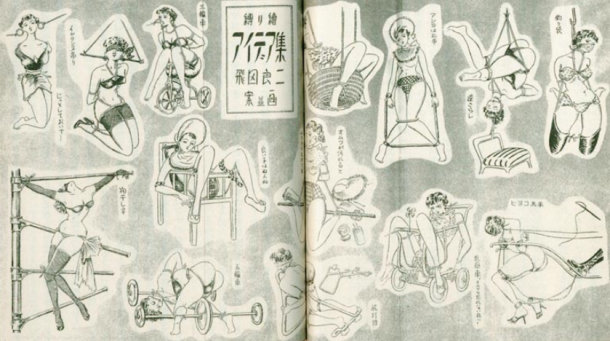
The book is also looking at what happens when rope comes to America and when leather goes to Japan in a similarly erotic context. In both cases you can see immediately it just isn’t the same thing, even if the objects are identical, the spirit is different and so are the outcomes. There are fascinating moments of cross-cultural influence, especially around people like John Willie, whom I have been able to better understand through his letters, interviews, drawings, and photography. His exposure to some of the images from Kitan Club magazine fundamentally altered how he did his bondage and brought a significant kinbaku influence to the West, even though it is generally not acknowledged.
Similarly, people often overlook the fact that a lot of Western art was showing up in many of these magazines of the time as well and that Kitan Club and Uramado and other magazines were publishing much more than just kinbaku photos and drawings, including Western fetish art and femdom images. The cross-cultural influences are much more complicated than most people assume.
Zetsu on the web:
Kinky LA
Ai Nawa


